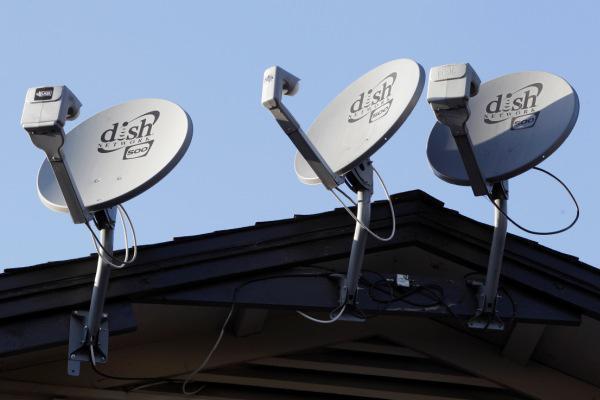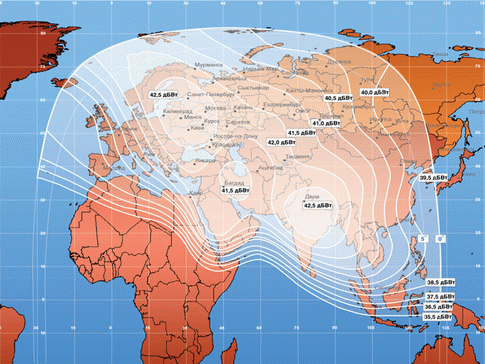That would mean broadband satellite technology to 100Gbit / s?
 Bashny.Net
Bashny.Net
If you like to travel or lead a dynamic life, but feel the need for a permanent, stable and, most importantly, fast access to the Internet, then you is the one who just needs HTS (High throughput satellite; satellite high bandwidth).

What is a satellite high-bandwidth? H5> HTS - a class of communication satellites that exceed at least 2 times (and sometimes 20 times) the nominal capacity of the classical satellite at the same band of frequencies. "Packaging" more bits in the same frequency range significantly reduces the cost per bit. The advanced technology used in satellites ViaSat-1 and EchoStar XVII (also known as Jupiter-1), are able to provide the bandwidth of more than 100 Gb / s. In other words, this technology can transmit data at more than 100 times as dense as compared with a conventional Ku-band satellite. In fact, the 140 Gb / s ViaSat-1, launched in October 2011, had more opportunities than any other commercial communications satellites over North America.
Overcoming stereotypes h5> In spite of the technological hype, some remains the feeling that satellite services can not cope with their tasks. This opinion is rooted mainly in satellite TV users, who are accustomed to that spoils the picture or lost during the rains. To minimize wobble weather conditions on the signal level, companies apply certain measures.
Georaspredelenie h5> Satellite operator must ensure the availability of individual satellite uplinks located in geographically remote locations. Spatial diversity ensures that if one of the uplinks suppressed heavy rain, then another in a reasonable distance, can take the load. This approach is not completely new, it is used for several decades in the good old microwave radio.
Adaptive Coding Modulation (ACM) h5> As with spatial diversity, ACM - also not a new concept. ACM has been used for many years in other wireless communication applications, including microwave radio. More recently, technology has found its place in the satellite communications. ACM adapts the modulation order used, and also uses forward error correction code. All this affects the spectral efficiency, expressed in bits per second per Hertz. Adjustments occur depending on the noise or other disturbances on the line. Thus, the ACM maximizes throughput regardless of conditions on the link, such as noise, attenuation due to rain, etc.
Consumer Business Opportunities h5> In order to fully assess the possibility of the consumer business, let's look at the deployment of the first satellite of consumer services - services satellite broadcasting Direct-To-Home (DTH). These services, including Dish Network and DirecTV, were first deployed in the consumer market in Japan, the UK and the US.
Business Opportunities h5> Ground providers predict the demise of the satellite industry in corporate communications almost every year, but in spite of this segment of the satellite services industry grew in the corporate market. One of the reasons - the availability of satellites at any location that is ideal, for example, for Ibox, which can be placed on the train, etc.
Pros and Cons h5> HTS has more power and packs more data into the carrier frequency than its counterpart C-band. HTS has a narrow beam and provides excellent quality of VoIP. Receiving requires less "plate" (0, 5 to 1, 5 m) as compared with 2, 5 - 4 m C-band dish.

What is a satellite high-bandwidth? H5> HTS - a class of communication satellites that exceed at least 2 times (and sometimes 20 times) the nominal capacity of the classical satellite at the same band of frequencies. "Packaging" more bits in the same frequency range significantly reduces the cost per bit. The advanced technology used in satellites ViaSat-1 and EchoStar XVII (also known as Jupiter-1), are able to provide the bandwidth of more than 100 Gb / s. In other words, this technology can transmit data at more than 100 times as dense as compared with a conventional Ku-band satellite. In fact, the 140 Gb / s ViaSat-1, launched in October 2011, had more opportunities than any other commercial communications satellites over North America.
These satellites will be able to provide a channel of 30-100 Gbit / s at any point on the globe.
So what are the possibilities open to users, remote workers and enterprises in particular? What will be the cost?
Overcoming stereotypes h5> In spite of the technological hype, some remains the feeling that satellite services can not cope with their tasks. This opinion is rooted mainly in satellite TV users, who are accustomed to that spoils the picture or lost during the rains. To minimize wobble weather conditions on the signal level, companies apply certain measures.
Georaspredelenie h5> Satellite operator must ensure the availability of individual satellite uplinks located in geographically remote locations. Spatial diversity ensures that if one of the uplinks suppressed heavy rain, then another in a reasonable distance, can take the load. This approach is not completely new, it is used for several decades in the good old microwave radio.
Adaptive Coding Modulation (ACM) h5> As with spatial diversity, ACM - also not a new concept. ACM has been used for many years in other wireless communication applications, including microwave radio. More recently, technology has found its place in the satellite communications. ACM adapts the modulation order used, and also uses forward error correction code. All this affects the spectral efficiency, expressed in bits per second per Hertz. Adjustments occur depending on the noise or other disturbances on the line. Thus, the ACM maximizes throughput regardless of conditions on the link, such as noise, attenuation due to rain, etc.
Consumer Business Opportunities h5> In order to fully assess the possibility of the consumer business, let's look at the deployment of the first satellite of consumer services - services satellite broadcasting Direct-To-Home (DTH). These services, including Dish Network and DirecTV, were first deployed in the consumer market in Japan, the UK and the US.

In the very beginning it was expected that the DTH satellite transmission will be limited only by the consumers of these services in places where there is no terrestrial counterpart. Surprise was the phenomenal interest in urban and peri-urban customers. It turned out that satellite TV was the best, competitive proposition for consumers who were fed up with the cable company. This has led to competition between providers of satellite TV and cable companies, which lasts to this day.
Returning to the HTS, as is the case with the debut of digital television, there was an expectation that satellite broadband will be relevant as the only hope for people who are not able to connect terrestrial broadband services. But also, as with DTH, why waste your time on trifles, if you can get more. Satellite and terrestrial providers will again fight for the hearts and minds of consumers around the world.
In general, the competition - it's good. For the consumer, this creates huge opportunities, as both sectors will improve and offer the most competitive prices and the capacity of the consumer.
Business Opportunities h5> Ground providers predict the demise of the satellite industry in corporate communications almost every year, but in spite of this segment of the satellite services industry grew in the corporate market. One of the reasons - the availability of satellites at any location that is ideal, for example, for Ibox, which can be placed on the train, etc.

Pros and Cons h5> HTS has more power and packs more data into the carrier frequency than its counterpart C-band. HTS has a narrow beam and provides excellent quality of VoIP. Receiving requires less "plate" (0, 5 to 1, 5 m) as compared with 2, 5 - 4 m C-band dish.
Rain strongly affect the propagation of high-frequency signal Ku-band (10, 12.7, 75 GHz) than the classic C-band (3, 4-5, 25 GHz). Although the band Ku improves its coverage is not as significant as that of conventional satellites, and latency can be significant, which is especially noticeable in online games.
Coverage Map Yamal 202, using C-band

And to compare the satellite map reception Horizon-2 operating in the Ku

In Europe and the United States is usually used, Ku band, while Asia and Russia are used both ranges.
At the moment, more than half of satellite operators ordered (or plan to order) satellites HTS. "Psychics" predict that 14 million users and 50% of the terminals at the enterprises will use the services of satellites with high capacity by 2020.
Part of this will be due to economic considerations.
For example, some media companies, "predict" price slide satellite news channel with more than $ 100,000 to less than $ 20,000 - 80% decline in prices. Another factor (more important) is the desire of the various segments of the market have access to network services anywhere and at any time. In this context of satellite Internet has a significant advantage.
HTS offers many opportunities for a wide range of applications in areas that were previously inaccessible. Cellular operators are expanding their coverage and concern markets that were previously unattainable via satellite. This is a significant advantage for consumers. However, it is still important to remember that, as with any service, Ku-band - not a panacea, and it is not suitable for all applications. It's just a tool in your arsenal, you can choose if necessary.
Source: habrahabr.ru/company/ua-hosting/blog/244527/
Tags
See also
Google can invest in space technology Virgin Galactic
Satellites for the World of Internet access will make Airbus OneWeb
What would happen if the Solar system will be a black hole?
Hello, I'm Alf
What happens if you go into space without a spacesuit?




















